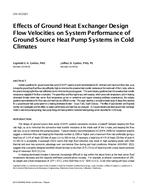Description
Industry guidelines for ground source heat pump (GSHP) systems provide recommendations for minimum and maximum flow rates, so as to keep the ground loop fluid flow rate sufficiently high to minimize the convective heat transfer resistance at the inside wall of the U-tube, while at the same time keeping the flow rate sufficiently low to minimize the pumping power. The same industry guidelines treat the convective heat transfer resistance as negligible if the flow is turbulent. The system flow and flow regime vary with viscosity, which varies with temperature, and in heatingdominated climates where heat carrier fluid temperatures go low in wintertime and require increasing antifreeze concentrations, the industry guideline recommendations for flow rates and head loss are difficult to meet. This paper describes a simulation-based study of design flow velocities for a ground-source heat pump system in a heating dominated climate – Sioux Falls, South Dakota. The effect of pipe diameter and Reynolds number are investigated and the effects on system performance and head loss are analyzed. An experimentally-validated ground heat exchanger model is used and pumping energy, heat pump energy and backup electric resistance heating energy are all accounted for in the study.
Citation: ASHRAE Papers: 2015 ASHRAE Annual Conference, Chicago, IL
Product Details
- Published:
- 2015
- Number of Pages:
- 8
- File Size:
- 1 file , 600 KB
- Product Code(s):
- D-CH-15-C021




